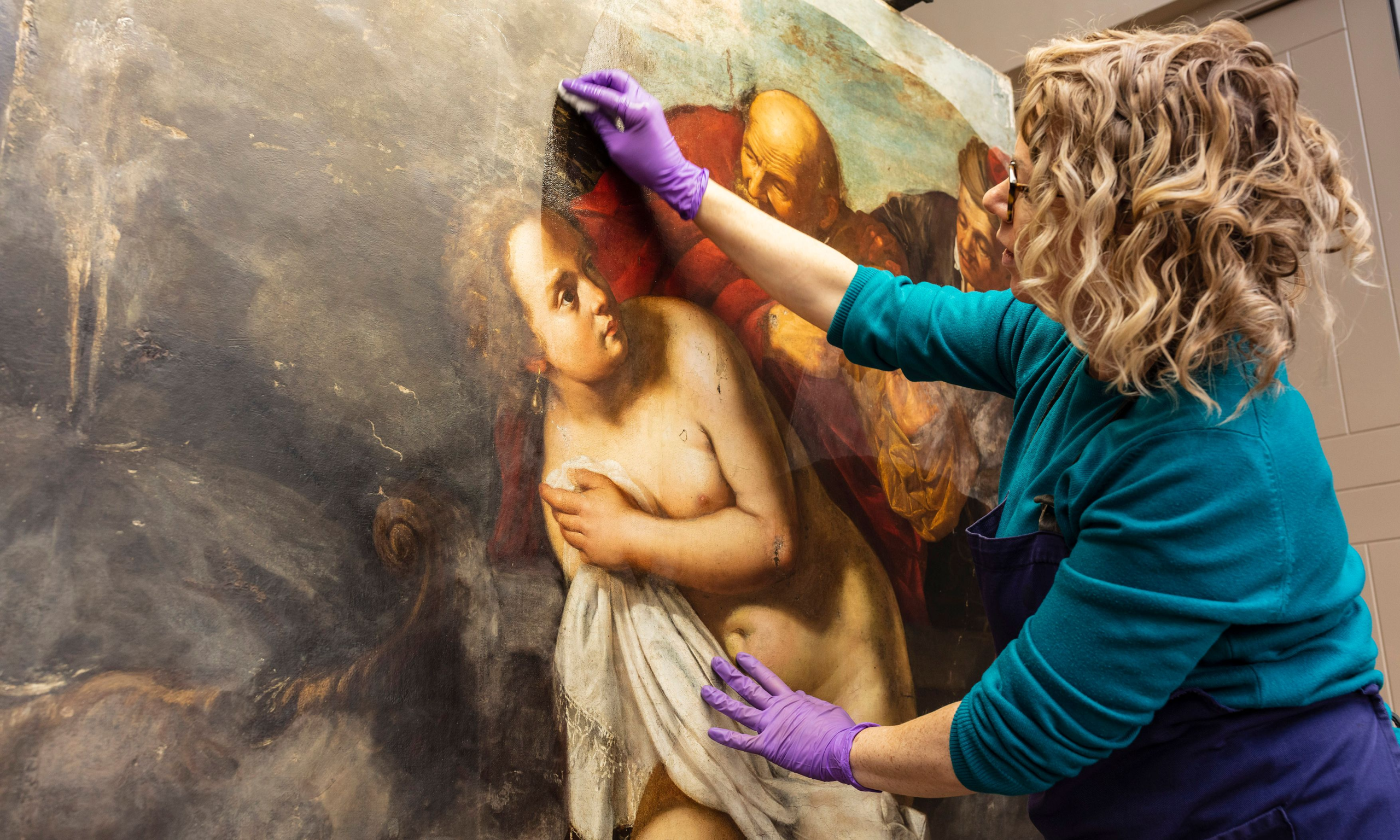Conservator Adelaide Izat working on Susanna and the Elders
Royal Collection Trust / © His Majesty King Charles III 2023
Curators at the Royal Collection, UK, have attributed a painting to the 17th-century Italian artist Artemisia Gentileschi, expanding the art historical canon of arguably Europe’s greatest female Old Master. The work, Susanna and the Elders, is thought to have been commissioned by Henrietta Maria, the wife of King Charles I (who ruled from 1625 to 1649), and throws light on the artist’s time in London in the late 1630s. The painting depicts the Biblical story of Susanna who is surprised by two men while bathing in her garden.
A Royal Collection statement says: “Research allowed curators to match the description of Susanna and the Elders to a painting that had been in store at Hampton Court Palace for over 100 years, attributed to ‘French School’ and in very poor condition. A ‘CR’ (‘Carolus Rex’) brand has subsequently been found on the back of the canvas during conservation treatment, confirming that the painting was once in Charles I’s collection.”
The newly attributed work was discovered by curators at the Royal Collection Trust as part of a research project led by the art historian Niko Munz focused on tracing paintings scattered across Europe after Charles I’s execution in 1649.
Artemisia Gentileschi's Susanna and the Elders
Royal Collection Trust / © His Majesty King Charles III 2023
Munz says in a statement: “One of the most exciting parts of this painting's story is that it appears to have been commissioned by Queen Henrietta Maria while her apartments were being redecorated for a royal birth. Susanna first hung above a new fireplace, probably installed at the same time as the painting, emblazoned with Henrietta Maria's personal cipher 'HMR' (‘Henrietta Maria Regina’). It was very much the Queen's painting.”
The painting was returned to Charles II shortly after the Restoration of the monarchy in 1660 and was later hung above a fireplace in Somerset House, London. It was then moved to Kensington Palace, later transferring to Hampton Court Palace, home of Henry VIII, where it was recorded in 1862 as being “in a bad state”.
Sheila Barker, Caravaggio expert and executive director of the Philadelphia-based art school, Studio Incamminati, tells The Art Newspaper: “The attribution is unassailable. Niko Munz and the Royal Collection's curators cross-checked a number of different kinds of evidence, including inventory descriptions, provenance records, and the collector's mark on the painting, in addition to making stylistic comparisons. They even carried out a material analysis that detected the presence of one of Artemisia's preferred pigments: lead tin antimony yellow.”
X-radiography (left) and infrared reflectography (right) have revealed changes that Artemisia made to the composition
Royal Collection Trust / © His Majesty King Charles III 2023
This discovery is a real breakthrough for several reasons, Barker adds. “First, we know it must have carried out in 1639 and completed no later than early 1640, by when she had departed England. This narrow window for the painting's execution is useful because only a very small percentage of her works can be dated with any certainty. Second, because she travelled to England alone, the paintings she carried out there are unadulterated by the hands of her major studio assistants or collaborators, thus furnishing a purer indication of her style. The Royal Collection Susanna is therefore a firm landmark by which to chart her stylistic changes in the 1630s and 1640s.”
The Lebanese art historian Gregory Buchakjian says: “Every new discovery is gold for scholars—it’s a piece to be added to an edifice that will never be entirely complete. The most Gentileschiesque features in the Hampton Court Susanna are the face of the female hero that reminds [us of] Artemisia’s Self Portrait as a Lute Player (1615-17) and Self-Portrait as Saint Catherine of Alexandria (1615-17).”
The newly attributed painting has gone on display as part of a new temporary exhibition in the Queen’s Drawing Room in Windsor Castle
Royal Collection Trust / © His Majesty King Charles III 2023
This new addition to Artemisia’s Susanna paintings also brings to the fore male figures in her work, that are less studied, more heterogeneous and often executed by collaborators, adds Buchakjian.
The newly attributed Gentileschi painting, which has undergone extensive restoration, has gone on display as part of a new temporary exhibition in the Queen’s Drawing Room in Windsor Castle alongside Self-Portrait as the Allegory of Painting (‘La Pittura’, 1638-39), also by Gentileschi, and Joseph and Potiphar’s Wife (around 1630-32) by her father Orazio Gentileschi.
The reattribution reflects the surge in interest in the 17th-century artist on both the institutional and commercial fronts. Last year the organisers of an exhibition exploring Gentileschi’s time in Naples attributed four works to the artist, fuelling debate around her practice and innovations.

